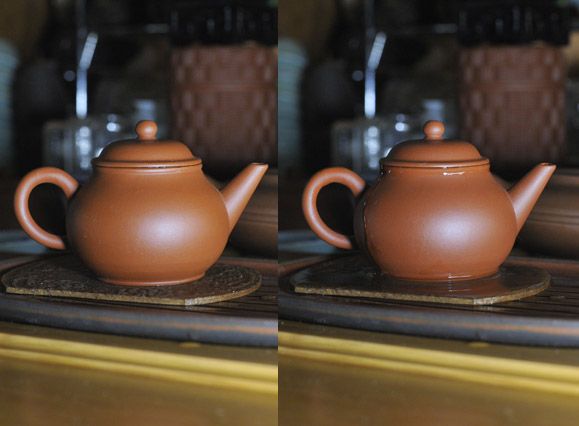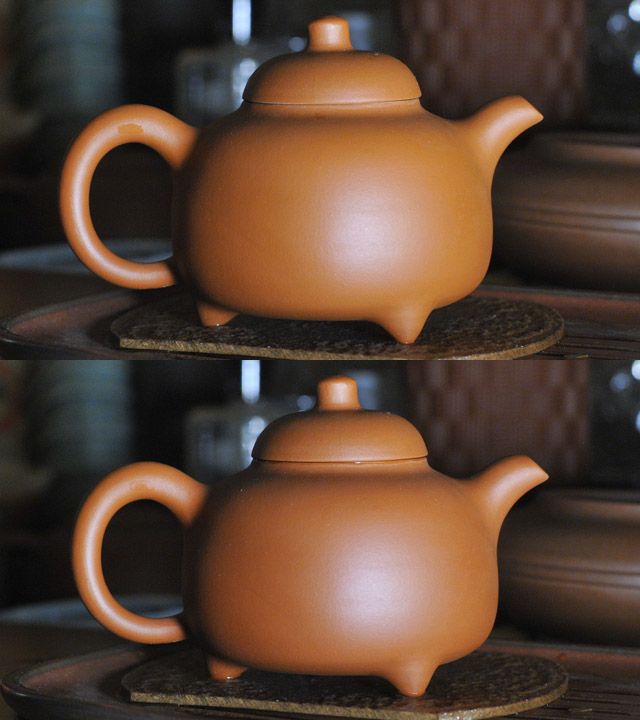Mountain people in Yunnan just boil Puerh in a kettle, likewise there is no rule settled down too strictly I think. Since when Puerh became so popular out of Yunnan? After 60's? Chaozhou Gongfu ceremony has history as early as 18C.Tead Off wrote:Many of the tea people I've met use zi ni pots for Puerh, not the red clay pots. Everyone knows that purple is the best color for Puerh. I would never allow a Puerh in my zhuni pot. Puerh and purple start with P. This should be obvious!
It's true lots of people prefer Zini or Di Cao Qing to make Puerh, but also lots of people I've seen use Zhuni for Puerh, early-made Zhuni for aged Shengs. Zhuni even looks better with some stains on. Plus high-fired, crystallized pots doesn't blot to seriously. To have Puerh juice brewed color darker than Yancha it at least needs over 10-yr of storage in a wet condition and how much money do we have to afford it?
Re: Affinity of Tea with the Teapot
being bored of the convention as usual i decided to take a re-read into Lim Kean Siew's book which is pretty much considered to be a little "mythological". in his book he talked about tea and pot matching and how the pot reacted colorimetrically.
incidentally after toying around with a bunch of yixing pots, there i did consistently observe some color changes in the pots i use during the brewing process and thought i would just revive this topic with some pictures. (pictures on top/left are prior to brewing, pictures on bottom/right are during brewing). all on same exposure, same lighting setup/intensity, same white balance, same ISO, aperture, shutter speeds, same lens and same camera, no photographic equipment bias nor voodoo here.
50s/earlier type hongni

60-70s type hong ni

end 80s niangao type clay

its all simple thermodynamics sorry mr lim, its not so much the tea that affects the color change but just the simple following scientific logics
sorry mr lim, its not so much the tea that affects the color change but just the simple following scientific logics
1) the hotter the water and the hotter the pot, the deeper the color.
2) with different kettles, pouring heights, spout types, the temperature of the water that hits the pot can be a variable, like if i use a small kettle (cz style) off the boil, the 80s niangao clay will become even redder than pictured during brewing
3) tea leaves do absorb thermal energy too, some more than the others, especially with much unfurling and rolling required.
4) if i dispense water in a thin stream from a height for sheng pu-erh, the color change in the pot is lesser than when water is dispensed fast and thick streamed into any of the pots.
5) the more regularly used the pot, the faster and deeper the color response.


incidentally after toying around with a bunch of yixing pots, there i did consistently observe some color changes in the pots i use during the brewing process and thought i would just revive this topic with some pictures. (pictures on top/left are prior to brewing, pictures on bottom/right are during brewing). all on same exposure, same lighting setup/intensity, same white balance, same ISO, aperture, shutter speeds, same lens and same camera, no photographic equipment bias nor voodoo here.
50s/earlier type hongni

60-70s type hong ni

end 80s niangao type clay

its all simple thermodynamics
1) the hotter the water and the hotter the pot, the deeper the color.
2) with different kettles, pouring heights, spout types, the temperature of the water that hits the pot can be a variable, like if i use a small kettle (cz style) off the boil, the 80s niangao clay will become even redder than pictured during brewing
3) tea leaves do absorb thermal energy too, some more than the others, especially with much unfurling and rolling required.
4) if i dispense water in a thin stream from a height for sheng pu-erh, the color change in the pot is lesser than when water is dispensed fast and thick streamed into any of the pots.
5) the more regularly used the pot, the faster and deeper the color response.
Aug 11th, '14, 14:45
Posts: 702
Joined: Sep 4th, '10, 18:25
Scrolling: scrolling
Re: Affinity of Tea with the Teapot
I've often noticed these color changes too but this is a nice documentation of the effect!
Aug 11th, '14, 15:29
Posts: 1144
Joined: Jul 10th, '13, 01:38
Scrolling: scrolling
Location: Japan.
Re: Affinity of Tea with the Teapot
I also noticed these colour changes on my pots. Definitely a great post! Thanks for the photos (and explanation)! 
Re:
actually if you do some photography the purple clay pot does not become "lighter" per say, but it becomes more "reflective"/smoother/glossier, giving the perception of it becoming "lighter"bonescwa wrote:What do you think about a purple clay pot turning lighter in color as it heats and darker as it cools? Maybe my imagination
Re: Affinity of Tea with the Teapot
In most cases, it's the opposite.bonescwa wrote:What do you think about a purple clay pot turning lighter in color as it heats and darker as it cools? Maybe my imagination